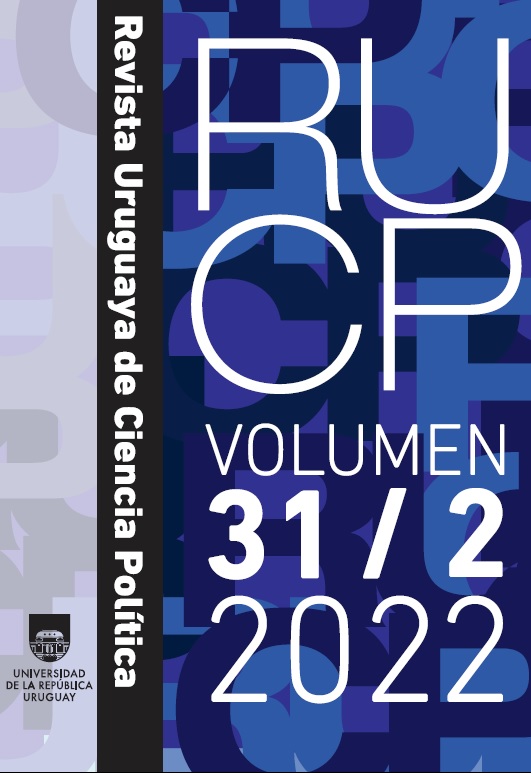Harry Blackmun and the Judicial Behavior studies. What can we learn from it?
DOI:
https://doi.org/10.26851/RUCP.31.2.5Keywords:
Decision making; theories of judicial behavior, judicial rationality, attitudinal models, Justice Harry BlackmunAbstract
This article analyses two key models of judicial decision‑making studies. The aim of this paper is to study the assumptions of the rational choice and attitudinal models in relation to existing studies on the way Justice Harry Blackmun voted during his tenure on the Supreme Court of the United States. In addition, this work analyses four emblematic cases judged by Justice Blackmun, through the perspective of ideological or strategic voting. Theories of voting in judicial behavior presuppose that judicial actors' decisions are guided by two broad types of rational possibilities: 1) they act strategically when align themselves with the choices of the authority who appoints them to office or on whom their re‑election depends; 2) they act out of conviction when, either because of their ideology or because of rulings within the legal technique, they make their decisions. The central thesis of this paper is that the analysis of Justice Blackmun's vote allows us to redefine, extend or look critically at several of the assumptions of the theories and models.
Downloads
References
BASABE SERRANO, S. (2012). Judges without robes and judicial voting in context of political instability: case of Ecuador’s Constitutional Court 1999 2004. Journal of Latin Amer-ica Studies, 44 (1), 127 161.
BENTON, D., y VAHLE, B. (2005). The Burger Blackmun relationship: lessons for collegiality from the Blackmun Papers. Missouri Law Review, 70 (4).
BRISBIN, R. (1992). The Burger Court Revisited. Polity, 25 (1), 159 171.
CAMERON, C., y KORNHAUSER, L. (2017). Rational choice attitudinalism? A review of Epstein, Landes and Posner's. The behavior of Federal Judges: a theoretical and empirical study of rational choice. European Journal Law Economic, 43, 535 554.
COHEN, A.; KLEMENT, A., y NEEMAN, Z. (2015). Judicial Decision Making: A Dynamic Reputa-tion Approach. The Journal of Legal Studies, 44 (S1), S133 S159.
CRANE, H. (2017). A hidden Markov model for latent temporal clustering with application to ideological alignment in the US Supreme Court. Computational Statistics and Data Analysis, 110, 19 36.
DRAGICH PEARSON, M. (2005). Revelations from the Blackmun Papers on the development of the Death Penalty Law. Missouri Law Review, 70 (4).
EPSTEIN, L. (2016). Some thoughts on the study of judicial behavior. William & Mary Law Review, 57 (6), 2017 2073.
EPSTEIN, L.; HOEKSTRA, V.; SEGAL, J., y SPAETH, H. (1998). Do political preference change? A longitudinal study of US Supreme Court Justices. The Journal of Politics, 60 (3), 801 818.
EPSTEIN, L.; POSNER, R., y LANDES, W. (2013). The behavior of Federal Judges: a theoretical and empirical study of rational choice. Cambridge, Estados Unidos: Harvard Univer-sity Press.
ESCOBAR JIMÉNEZ, C. (2018). Criterios de demarcación, pseudociencia y cientificidad en el derecho. Cinta de Moebio, 61, 123 139.
FEIST, L. (2020). A Judge's vote, and the people's: how do elected Judges make decisions? Haverford, Estados Unidos: Haveford College.
GREENHOUSE, L. (2006). Becoming Justice Blackmun: Harry Blackmun’s Supreme Court Journey. Nueva York, Estados Unidos: Times Books.
GRIJALVA, A. (2010). Courts and Political Parties: The Politics of Constitutional Review in Ecuador. Tesis doctoral. University of Pittsburgh.
HAGLE, T. (1993). A new test for the Freshman Effect. Southeastern Political Review, 21 (2), 289 308.
KOBYLKA, J. (1989). Leadership on the Supreme Court of the United States: Chief Justice Burger and the establishment clause. The Western Political Quaterly, 42 (4), 545 568.
KOH, H. H. (1994). Justice Blackmun and the «World out There». The Yale Law Journal, 104 (1), 23 31
LIJPHART, A. (2000). Las democracias contemporáneas: un estudio comparativo. Madrid, España: Ariel.
MARTIN, A., y QUINN, K. (2002). Dynamic ideal point estimation via Markov chain Monte Carlo for the US Supreme Court, 1953 1999. Political Analysis, 10 (2), 134 153.
MISHKIN, P. (1975). Great cases and soft law: a comment on United States v. Nixon. UCLA Law Review, 22.
RIES, D., y JARRELL, M. (2002). Expert opinions in environmental cases after Daubert Amended Federal Rule 702. Energy and Mineral Law Institute, 22. Chapter 13.
RUGER, T. (2005). Justice Harry Blackmun and the phenomenon of judicial preference change. Missouri Law Review, 70 (4), 1119 1230.
SCHWARTZ, B. (1979). Bad Presidents make hard law: Richard M. Nixon in the Supreme Court. Rutgers Law Review, 31, 22 40.
SEAGAL, J., y SPAETH, H. (2012). The Supreme Court and attitudinal model. Cambridge, Reino Unido: Cambridge University Press.
SHEPHERD, J. (2009). The influence of retention politics on Judges’ voting. Journal of Legal Studies, 38 (1), 169 203.
SISK, G. (2005). The Willful Judging of Harry Blackmun. Missouri Law Review, 70 (4), 1049 1073.
TOCQUEVILLE, A. (2015). La democracia en América. Ciudad de México, México: Fondo de Cultura Económica.
TRIBE, L. (2012). El aborto: guerra de absolutos. Ciudad de México, México: Fondo de Cul-tura Económica.
TSEBELIS, G. (2006). Jugadores con veto. Cómo funcionan las instituciones políticas. Ciudad de México: Fondo de Cultura Económica.
VANBERG, G. (2005). The politics of constitutional review in Germany. Nueva York, Estados Unidos: Cambridge University.
WEINGAST, B., y MARSHALL, W. (1988). The industrial organization of Congress: or why Leg-islature, like firms, are not organized as markets. Journal of Political Economy, 96 (1), 132 163.



























